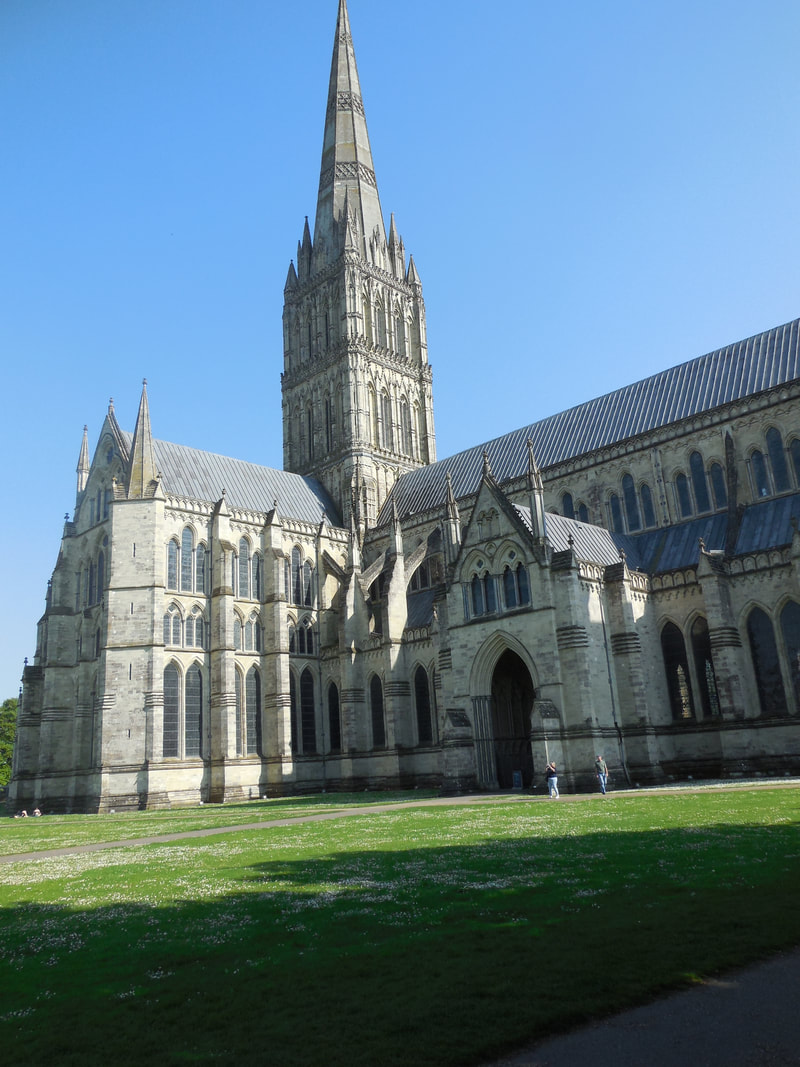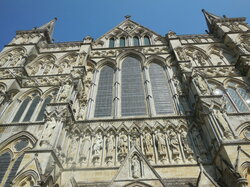

|
Last summer I had the good fortune to visit Salisbury Cathedral twice. I've visited long ago, but I particularly enjoyed my visits in 2018 because on both occasions, the organ and choir were in full voice, once in rehearsal, the other time during a service.  The photo above was taken in the Cathedral Close in May, while that below was taken in mid July. Note how the lawn dried out in the torrid summer of 2018 in the UK. The Cathedral was begun in 1220 and completed in a mere thirty-eight years, an amazing feat. The West Facade includes more than seventy statues, making a striking invitation to enter.  Facade of Salisbury Cathedral The nave is unusually tall and narrow, and the ceilings have been repainted to approximate the appearance in the thirteenth century. Salisbury Cathedral Salisbury Cathedral Cloisters were added in 1240. Above, entering the Chapter House, built in 1263. It exhibits one of the four remaining copies of the Magna Carta, the document signed by King John in 1215 which acknowledges his sharing of power with the nobles. As one of the foundations of democracy, it is revered throughout the world. This reproduction of the original shows what it looks like; to protect it, very low light is available and no photographs are allowed. The windows of the Chapter House, however, are particularly beautiful in the sunshine. The Salisbury spire is the tallest Church spire in the UK. I cannot resist including a few versions, below, of views of the Cathedral painted by the celebrated English artist John Constable, RA, (1776-1837). He painted the Cathedral from various viewpoints many times. Note the importance of the art museums in which they hang. And there are more! What more perfect picture of England than these could you imagine?
1 Comment
Above, the Throne Room of the Iolani Palace, Honolulu, Hawaii. Last week, I tried to give a capsule version of how Hawaii developed its monarchy, which continued from 1810 to 1893. It was in the last two decades that the Iolani Palace was built and lived in by the monarch. David, King Kalakaua (1836-1891) was chosen King in 1874. chosen. He was educated with the sons of chiefs, spoke fluent English, had a lively interest in science, and affection for native Hawaiian cultures He traveled in the US and Europe, spending time in London where he was received and entertained by Queen Victoria. Above portrayed in 1891 by artist William Cogswell, he wears the decorations awarded him by the rulers of six major nations. The Grand Hall and Staircase in Iolani Palace. The ground floor was used for social gatherings. Below, the State Dining Room. Remember to click on the images for larger versions. Above, the Blue Room, used for smaller receptions and entertainments. The Hawaiian Royal Family traveled extensively and visited with royalty all over the world. Above and below, the King's office and Library. Below, the Upper Hall, Below, the King's Bedroom. The feathered standard on the left of the bed is a traditional symbol of Hawaiian royalty. Above, the King had the latest technological advances installed: plumbing, telephone, and electricity. Below, the Queen's bedchamber. Above, the Gold or Music Room. Note the gifted elephant tusks and the portrait of Queen Kapi'olani. Queen Lili'uokalani (1838-1917), sister of King Kalakaua, succeeded her brother after his death in 1891. Lili'uokalalni was an artist and poet, and composed many songs, often based on traditional island themes. She was widely traveled and represented the King at Queen Victoria's Golden Jubilee in London in 1887. However, within a few years of both internal and external difficulties, she was forced to give up "...administration of Hawaii to a pro-annexation group Honolulu businessmen who promptly formed a Provisional Government," in the words of the palace guidebook. Above, the Coat of Arms of the Hawaiian Kingdom. After attempts to re-form the monarchy failed, in 1895, the Queen was tried and imprisoned in her former palace, which was then known as the executive building of the Republic of Hawaii. Hawaii became the 50th state of the United States of America in 1959. The Royal Family's descendants and many others work hard to honor and support native culture and traditional customs. The Queen was held in one of the upstairs bedroom for almost eight months before she was released. This quilt is displayed in the Imprisonment Room; quilting was one of the pastimes with which she occupied herself while in custody. Later she divided her time between homes in the U.S. and Honolulu. On the grounds of the Iolani Palace is the Coronation Pavilion, constructed in 1883, and now used for band concerts and as a center for public celebrations. Below, the Palace as it stands today, under the care of Friends and the State of Hawaii, and open to the public. Aloha!
Above, the Iolani Palace, Honolulu Hawaii Below, the Throne Room On a recent visit, my first, to Hawaii, I was pleased to visit this palace in the center of Honolulu, built in the 1880's. The palace boasted the latest in indoor flushing sanitary conveniences, electric lighting, and telephones, all installed at the behest of King Kalakaua (1836-1891). I was very interested in reading about Hawaii’s history. The islands were created by the gradual accumulation of lava from underwater volcanoes deep below the Pacific Ocean. According to the sources I read, over millions of years the islands grew until they broke through the surface, one by one, thousands of miles from other land masses. Scientists at the Bishop Museum (above) showed us evidence of a new island forming and in only 30,000 years (or was it 300,000?), the will be a new island emerging, already named Lo'ihi. The “new” land was composed of lava, which is sometimes solid rock, other times pulverized by wind and waves. Flora and eventually fauna arrived by wind, ocean currents, birds, and insects. Over millions of years, the islands developed in near isolation. The oldest of the islands is Kauai, which is also the greenest. Below, Opaeka'a Falls, Kauai Estimates vary, but human arrivals probably began less than two thousand years ago. People from far away islands in Polynesia came, probably in outrigger canoes (modern versions on the beach, below), an amazing feat. Each island was slowly inhabited but the details can be discovered only in legend and myth. The oral tradition is the only source of history before the 18th century. Some speculate that Spanish and/or Portuguese explorers stopped by before, but if so, the specific evidence is still undiscovered. Captain James Cook (1728-1779) visited Hawaii two times on his third Pacific voyage in 1776-79. A skilled cartographer, his maps of previously little-known lands were met with great interest by the British. The artists and scientists on board his ships brought back the sketches and stories of distant and exotic lands, as well as many artifacts and plants, some of which were planted at Kew Gardens and elsewhere. Below, Cook, by Nathaniel Dance, 1775-76. Cook himself was killed in Hawaii in what is commonly thought to be a partially accidental incident. A town on the big island is named Captain Cook (note the shot I snapped as our tour bus passed the post office). The spot where he was killed is marked by an obelisk, and a statue of Cook stands on the island of Kauai near his first landing. It was not long before the Christian missionaries followed the explorers to all the areas visited, including the Hawaiian Islands, which Cook named Sandwich Islands. For several decades, the quarrels and occasional battles among the tribes living on the various islands continued. The pre-European- arrival culture of the islands is preserved in some locations, such as the Pu'uhonua O Honaunau National Historic Park, below. I've taken up way too much space to give you the interior of the palace this time, so come back next week for more.
Aloha! I am taking down my Christmas Tree, wee though it is, and I thought I'd write a quick post about Twelfth Night, not a holiday widely celebrated around here, except in church, related to the Feast of the Epiphany. I naturally turned to Wikipedia and some articles from newspapers and discovered little agreement about what Twelfth Night is--or when! What's a busy blogger to do? I thought it was simple. Twelfth Night marks the arrival of the Three Wise Men at the stable in Bethlehem to bring their gifts (who could turn down Gold, Frankincense and Myrrh, whatever the last two are?) to the Christchild. Well, yes, but...when do you start counting the 12 days? does the term refer to the eve of the twelfth day or its post-twilight? Should it be celebrated on January fifth or sixth? What did Shakespeare say? I found only further complications as I tried to sort out the play's cross-dressing characters and rogues such as Sir Toby Belch, and Sir Andrew Aguecheek. I learned it was first performed at the end of Christmastide as it was observed about 1602 on February 2. Go figure. Not any help at all. Thanks, Bill. But I did learn from several sources that some people prone to superstition believe that taking Christmas decorations down after Twelfth Night is bad luck. Why take a chance? I am now returning to my other tasks. I have yet to make those resolutions for next -- whoops -- this year.
|
Victoria Hinshaw, Author
Archives
July 2024
Categories |
